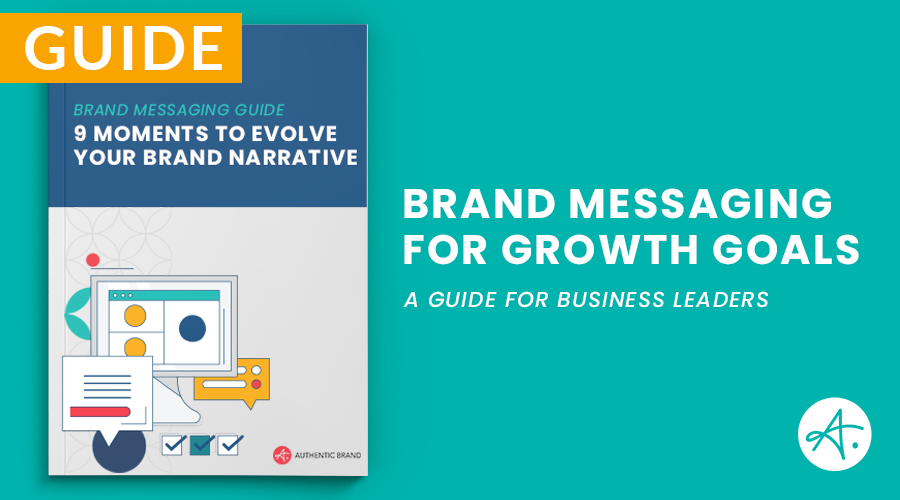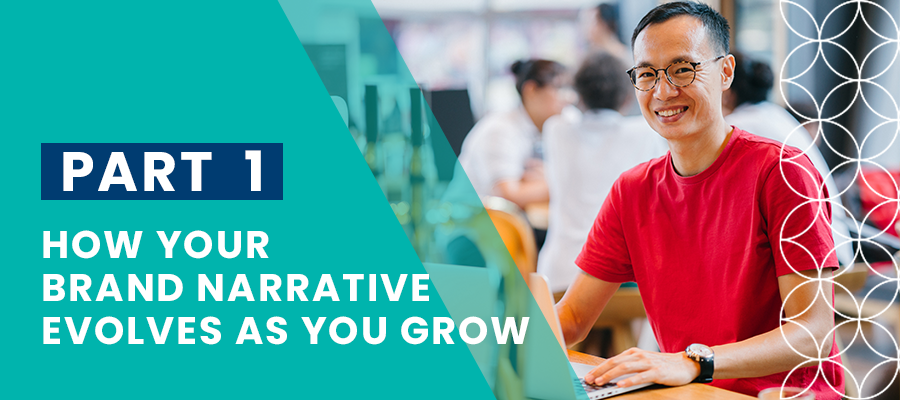
A brand narrative is the story your brand tells the world. It serves as the foundation of your marketing and communications strategy. This story should concisely describe why you do what you do, how you do it, and what makes you stand out from the sea of sameness. Most importantly, the story must be framed with your target audience in mind: helping them to “see themselves” in the narrative.
When you create a brand narrative, it’s important to remember that it’s a journey, not a destination. The lifecycle of a business includes a tremendous amount of change: from launch, through various growth stages, to eventual exit or new evolution. Every major milestone along the growth journey creates an opportunity to rethink the brand story, and ensure it’s aligned to the audiences who matter most at these crucial moments.
That said, creating your brand narrative is never one and done. As your company grows, your brand narrative has to evolve. This allows you to keep up with new internal and external challenges that every growing brand faces.
In our Brand messaging guide, Authentic looks at nine milestones in company growth that affect a brand’s narrative and create “messaging moments.” These messaging moments are opportunities to reassess your brand’s narrative to ensure it meets your business’s needs today while positioning you strongly for the future.
9 brand messaging moments

1. When launching your business
Starting up a business takes guts, hustle, and, if you hope to spark interest and create immediate sales momentum — a strong story. This is perhaps the most obvious time to ensure your brand is well-differentiated and supported by a concise, customer-focused narrative.
You only get one shot at launching your business, and you don’t want to miss the chance to make a solid first impression.
But for many new businesses, “branding” stops at logo design. This is well short of a fully articulated brand strategy and isn’t a sustainable strategy for growth.
While your new company invests in carefully planned product development, processes, hiring, and infrastructure, messaging typically evolves as an ad hoc response to individual sales opportunities. Before long, leadership wonders how they ended up with a customer mix that doesn’t match the original intent of the business.
To create qualified business opportunities (those that best align with the value your business can deliver) you need to start with a story that establishes boundaries to qualify and disqualify would-be buyers. Clear positioning right out of the gate is essential to building your strongest, most sustainable customer portfolio.
2. When you’ve outgrown your origin story
Your fledgling business has grown, and you’re not what you once were. You’ve added talent, refined your processes, listened to your customers, and responded with new services or products that provide them with greater value. Your “Story Version 1.0” no longer fits, and that’s OK. Your story should evolve as your business changes.
This is a perfect time to revisit your brand strategy and story. Most likely, when you first started the business, you (or a very small team) owned the brand narrative. Today, your business represents a more complex network of relationships: employees, partners, customers, and perhaps investors. This is an opportune time to capture key stakeholder input and ensure that the story you shape resonates with all the relationships that matter most to your business.
You’ll want to be thoughtful in the message-updating process to clarify roles, especially for your internal stakeholders. Clearly differentiating who has a voice, who has a vote, and who’s only there to provide input will make the process easier. Everyone’s input is valuable, but ultimately, the marketing department (with the support of executive leadership) will own the execution and outcomes of the updated brand. Make sure you set your marketing leaders up for success with the ownership they need to lead this process forward.
3. When building the upstream pipeline
It’s a common scenario: Many growth-focused businesses reach their first $5M, $10M, or even $25M through a strong sales effort and personal relationships that have driven exclusive referrals. It’s not too hard to win if you’re the only vendor at the table, and the buyer has already expressed a specific need. But eventually, the referral-based growth trajectory slows down, and leadership recognizes that to reach their goals, the company will have to engage audiences that don’t yet know the brand. This means showing up in new, more competitive circles.
At this point, marketing moves from being reactive and experimental, to proactive and strategic. Before you push into new markets and audiences, you’ll need to make sure your story stands out and can be delivered consistently across channels: from the first digital impression to the sales closing conversation.
This is usually when it becomes obvious that the company has what we call a “What” message. All of your successful, early-stage selling revolved around the later stages of the sales funnel when your customers were ready to buy. That kind of message tends to be very product, service, process, feature, or company-focused. These are all useful positioning strategies in a sales conversation, but not effective for marketing up-funnel to potential buyers who are not yet ready to engage with sales.
To capture future buyer interest, you have to lead with a “So What” message: a story that starts with the buyer, their pains, goals, and values, and then naturally leads to your solution. It sounds easy, but if it were, most businesses would have this dialed in. And surprisingly, most don’t. In fact, most businesses suffer from nearsightedness when it comes to messaging. They are simply too close to the subject matter to see objectively and struggle to translate their value proposition in a way that buyers can easily understand. As a result, many businesses fall back on copy-cat methods, ending up with a story that looks and sounds like their competitors.
Once you’ve made the shift from “What” to “So What,” you’ll be in a strong position to elevate conversations with potential buyers, moving engagement up the funnel from “ready to buy” to “ready to learn more” and creating a healthy engine for pipeline growth.

4. Flavor-of-the-Day Messaging: Combating maverick branding as your team grows
As a kick-off to many of our client workshops, we use a simple brand sprint exercise called “The Two-Sentence Story.” We ask every participant in the room to write their business’s (or product’s) story in their own words and without looking at any brand collateral.
For some people, this simple exercise evokes extreme anxiety. Others can’t wait to articulate their expert understanding of the brand. In either case, the resulting stories are always telling. There are usually common words, phrases or themes that show up across stories (which tend to be the truest, most authentic aspects of the brand story). At the same time, there is always the realization that there are as many versions of the brand story as there are people who represent the brand.
Of course, we expect, and advocate for, individual personality and expression among employee brand ambassadors. A healthy business empowers its people to add their voice and experiences to their expression of the brand. But an individual clearly expressing your brand message is very different from “maverick messaging” based on personal preference. This is where businesses run into trouble, and we see this challenge most often in businesses with team members who span a large tenure time-range. In other words, if your top sales rep and lead product engineer have been with the business for 15+ years, but your marketing director and CEO joined in the past two years, then you’re likely to experience some mixed messaging mayhem.
The worst thing you can do in this situation is to push out messaging from the marketing ivory tower. Your mavericks just aren’t going to buy it, and you’ll risk creating brand dissension among the ranks. Since a house divided against itself can’t stand, it’s really important to bring internal stakeholders to the table, especially those in leadership roles, as well as your highly-tenured, most successful team members. In soliciting team member input, it’s important to lay the expectations about who has a voice vs. who gets a vote, so everyone knows what role they play in building and supporting the brand story.
One aspect of Authentic’s Authentic Growth® Methodology™ is a messaging workshop. The deliverable from the workshop isn’t the most valuable output to come from it; the workshop itself is often the most valuable aspect. The workshop serves to equalize the voices in the room, help every stakeholder feel engaged, and bring the team together to align around decisions that will ultimately be made and carried forward by marketing.
Sometimes your messaging mavericks just need to be heard and affirmed. And oftentimes, it’s easier to be heard when a third-party facilitator can help make sure that the loudest voices don’t dominate the conversation. Once heard, most maverick messengers are willing to fall in line with a new direction, knowing that they helped to shape the outcome. This kind of inclusion is the greatest way to activate a united messaging front within the organization that naturally creates brand unity externally.
5. When your brand is the best-kept secret
It’s amazing how many businesses can successfully grow under the radar or even completely off the grid of the broader business community. Strong product, service, leadership, and sales relationships have been the foundation of their growth, and their customer relationships are solid. But unless you work in the business, or work with the business, you have no idea they exist.
If this describes your business, congratulations! You’ve done the heavy lifting of building a meaningful offering that your customers value. You have all the right ingredients, but to keep growing, you need to share your recipe with new audiences. If you’ve never invested in brand and messaging strategy, then you’ll need to approach your messaging process like a new company launch: evaluating every aspect of your brand from logo and standards to narrative and channels for engagement.
To support your messaging strategy, you’ll need a comprehensive marketing plan that helps your team align around market focus, top differentiators, competitive landscape, budget, annual goals, and key metrics. You may discover that you don’t have the right level of expertise in-house to guide this process and lead execution. You may not be ready to hire a full-time VP of Marketing, but a fractional marketing leader can be a great solution to help bridge this period of growth in your business, offering all the experience of an executive marketing leader, on a part-time, flexible basis.
When “best-kept secret” businesses make the decision to come out from hiding and grow with intention, they often recognize that their operational systems also need a refresh. The way they’ve managed business planning, human resources, communications, operations, finance, and culture may not be well-poised to support growth at scale.
Authentic has developed its own methodology to help small, growth-focused businesses build strategic marketing programs and create alignment between sales and marketing. Our Authentic Growth® Methodology™ relies on simple tools and a structured process to establish accountability and focus – ultimately eliminating Overcome Random Acts of Marketing® to help high potential businesses achieve next-level results.
6. When messaging a new product or service launch
The launch of a new product or service, or the expansion into a new market or buyer demographic, presents an ideal opportunity to evolve messaging and channel strategies.
A new offering may not change your overall brand/corporate narrative or your company’s brand purpose, but it will create the need to rethink how you position customer value at the sales or marketing campaign level. You get one chance to launch your new offer to the market, and sales and marketing alignment in storytelling are critical at this milestone moment.
Authentic Fractional CMO™s employ a number of proven brand sprint methodologies to help leadership teams quickly align with core brand attributes. One of our favorite sprint tools is the “Golden Circle,” introduced by Simon Sinek in his now-famous 2009 TED Talk. This simple exercise helps teams hone in on their brand purpose (Why), unique differentiation (How), and core offerings (What).
A new product or service launch very rarely shifts a company’s brand purpose, but it can have an impact on how the company uniquely differentiates and most certainly changes the mix of offerings.
Change can create confusion, both internally and externally, so it’s important to have clarity on how the new product or service supports or shifts the brand story. An updated, documented brand guide and messaging framework will keep your internal teams aligned, and support consistent messaging to the market that strengthens the impact of your launch.
Creating brand and message alignment prior to a new offering launch may mean taking more time upfront for strategy and planning, but the results will be worth it. The fastest path to growth is making sure your team is aligned to bring a consistent message to your buyers from marketing through the entire sales cycle.

7. When building a compelling fundraising message
Potential customers aren’t the only audience that matters when it comes to brand storytelling and messaging strategy. Many growth-focused businesses will eventually look for external funding to help propel the brand to market and support investment in talent, product, or service innovation.
When it comes time to raise funds, whether through banking relationships, friends and family, or venture capital funds, your story matters as much as your numbers. Here’s why: neuroscience confirms that all people, even very educated, analytical, experienced investors, ultimately make decisions based on emotion, rationalized by logic.
This article published by Customer Think and authored by Michael Harris (author of Insight Selling), explains that 95% of purchase decisions take place unconsciously, but that “our conscious mind will always make up reasons to justify our unconscious decisions. It does this to maintain the illusion that our conscious mind is in charge.”
If it’s true that business buyers lean heavily on emotion for purchase decision-making, the same can be assumed of business investors. Compare any two businesses with similar financials and projections: the best story will win.
Before you kick off your fundraising round, take the time to review your story through the lens of the investor persona. Understand both their logical and emotional triggers, and make sure you have a “So What” message that is customized to appeal to this audience.
8. When telling a new merger or acquisition story
One of the biggest changes a business can experience is the integration of cultures, products, services, systems, and talent brought about by a merger or acquisition. I’ve been part of a company that thrived through these growth-driven disruptions, and I’ve also experienced the utter chaos of acquisitions done poorly, resulting in cultural confusion and the mass exodus of talent. As the marketing leader at the center of the former, I can attest that communication, both internally and externally, is one of the (if not THE) most important determining factors for successful mergers and acquisitions.
In the ideal scenario, as the merger and acquisition deal moves toward a close, the mutual leaders are actively crafting messaging, not just for PR and media gains, but to proactively and authentically align internal and external audiences on what the change will mean for them, and on what timeline. This is a unique kind of “So What” message and very important to securing stakeholder trust at what can feel like an unsettling time.
In the 2009 TED Talk when Simon Sinek introduced the concept of The Golden Circle (which we mentioned earlier), Simon made a compelling point: “People don’t buy what you do, they buy why you do it.”
It’s easy to understand and explain how a merger or acquisition affects a brand’s “What” – its products or services. It takes a bit more nuance to express how the deal affects the brand’s “How” – its unique differentiation/delivery mechanisms. In the case of mergers where each brand retains strong influence, it can be especially challenging to express the impact on the combined brand’s “Why” – its purpose for existing.
The most successful merger and acquisition deals are done when two businesses, and their leaders, align and agree on how they will mutually and authentically message the What, How, and Why of the combined entity. Clarity at the messaging core helps build trust and credibility internally, which translates into confidence externally, all of which are required to retain and grow a strong talent and customer base.
9. When selling your business
Every decision you’ve made about your business, brand, and strategy has led you to this pivotal point in time: preparing to sell your company. If your exit strategy relies on selling to an outside party, this is a critical storytelling moment for your business.
Start by thinking about what success means as you sell: for yourself, and for your employees and partners. What kind of acquirer will you need to attract and secure to create that success? What matters most to that potential buyer? Most likely, your future buyer will be assessing several potential acquisitions. Your business needs to stand out from the crowd.
You already know that a savvy business acquirer will scrutinize your financial statements, customer portfolio, operating process, talent, and overall infrastructure. But don’t overlook the value of your brand story in the acquisition decision process.
Remember the article we mentioned earlier that says neuroscience confirms that all people, even the most analytical and logical, ultimately make decisions based on emotion, rationalized by logic? Story, not data, plays the leading role in buyer decision making, even in the case of corporate acquisitions. Begin by making sure your story differentiates you from other would-be acquisition targets, and then back it up with all the data and analytical reporting to support the decision.
Are you ready to evolve your brand narrative?
As you grow, your business will evolve, and your brand messaging will need to keep pace. Crafting an effective, evolved brand narrative will depend on your ability to keep the magic alive that helped your brand grow in the first place. By staying true to your roots with your brand message, you’ll be well-positioned to hit all of the key milestones your company strives for with clarity, alignment, and focus.
Brand messaging isn’t a one-and-done exercise. It’s a journey full of twists and turns. Entrusting your brand’s evolution to a strategic marketing leader will help your company stay firmly focused on what’s coming next, so you can adapt your brand messaging to fit your ever-changing needs.
Are you nearing one of these key brand messaging milestones but don’t have an experienced marketing leader to guide you through it? Authentic’s Fractional CMOs offer strategic guidance on a part-time, flexible basis to help you move forward with confidence.
Our proprietary Authentic Growth® Methodology™ helps growth-focused businesses build strategic marketing programs and create alignment between sales and marketing. One of the first steps in our process is defining and documenting your strategic brand narrative.
Contact Authentic today to discuss how our team of experienced marketing leaders can help shape and evolve your brand message for continued success.








